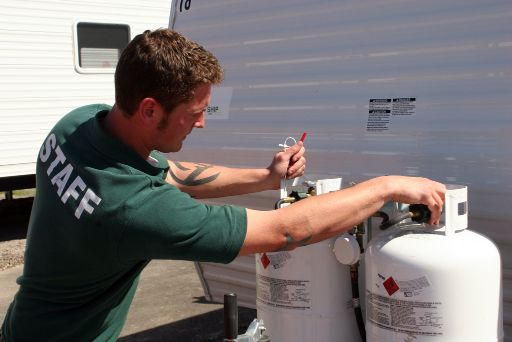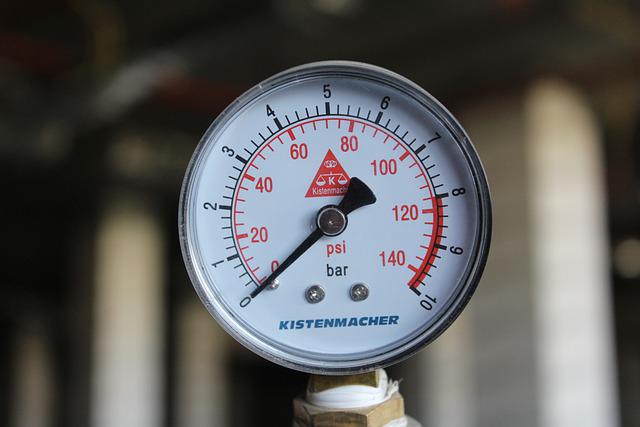
If you’re wondering whether a propane tank can be next to a driveway, the answer is yes! In fact, propane tanks are often placed next to driveways since they need to be close to the home or business in order to supply fuel for appliances. However, there are a few things to keep in mind if you’re planning on placing a propane tank next to your driveway.
Many people choose to have a propane tank installed next to their driveway for convenience purposes. This can be perfectly safe as long as the tank is installed and maintained properly.
Here are a few things to keep in mind if you’re considering having a propane tank next to your parkway:
- The tank should be installed by a certified professional according to local code requirements.
- The tank should be regularly inspected and maintained to ensure that it is in good working order.
- The tank should be properly labeled and positioned so that it is not a tripping hazard.
- The area around the tank should be clear of debris and other potential hazards. If you take these precautions, having a propane tank next to your parkway can be a perfectly safe and convenient option.
How far can the propane tank be from driveway?
Typically, a propane tank can be anywhere from 50-80 feet from a driveway, but it’s always best to check with your local authorities to be sure. This is to ensure that the hose of the delivery truck is able to reach the tank during refill.
The length of the hose on a propane delivery truck can vary depending on the size of the truck and the amount of propane being delivered. The average length of hose on a propane delivery truck is about 80 feet. The hose is typically made of rubber or plastic and is coiled up on the side of the truck.
Propane tanks are subject to a variety of regulations and guidelines, both for safety and to ensure seamless operation. If you’re considering placing your propane tank near a driveway or road, it’s crucial to be informed about these standards.
Zoning and Safety Regulations
- Local Zoning Laws: Before installing a propane tank, you should check with your local city or county’s zoning office. They will have specific guidelines on where you can and cannot place your tank, especially concerning its proximity to roads.
- Distance from Ignition Sources: Many safety regulations dictate a minimum required distance between the tank and potential ignition sources, such as electrical appliances, open flames, or even car engines.
- Barrier Requirements: In some places, if you’re placing a tank near a parkway or a high-traffic road, you might be required to install barriers or bollards to protect the tank from potential vehicle impacts.
- Setback Distances: Safety codes often prescribe setback distances, indicating how far away the tank needs to be from structures, property lines, and roads.
Recommendations from Propane Suppliers and Industry Experts
- Placement Flexibility: While regulations give the minimum requirements, industry experts often advise on best practices. For instance, even if a tank is allowed near a road, it might be recommended to place it a bit farther away than the minimum required distance for added safety.
- Tank Accessibility: Suppliers emphasize the importance of easy accessibility. This ensures that the tank can be quickly filled, inspected, or serviced without any hindrance.
- Underground Installation: Many experts might suggest underground installation for larger tanks. While this may have a higher initial cost, it protects the tank from potential impacts and the elements, prolonging its lifespan.
- Regular Inspection: While this is both a regulation and a recommendation, having your tank routinely checked ensures it adheres to evolving safety standards and remains in good working condition.
In conclusion, while you have some freedom in where you place your propane tank, it’s essential to prioritize safety. Make sure to consult both local regulations and your propane supplier’s recommendations to find the optimal spot for your tank.
To make sure contact your propane company about the requirement.
How far can a propane tank be from the road
There are many different factors to consider when deciding how far a propane tank can be from the road. The most important factor is the size of the propane tank. Smaller tanks can be placed closer to the road, while larger tanks should be placed further away.
Another factor to consider is the purpose of the propane tank. If the tank is being used for personal use, it can be placed closer to the road. However, if the tank is being used for commercial purposes, it should be placed further away. Additionally, local laws and regulations should be considered when deciding how far a propane tank can be from the road.
Alternative Safe Locations for Propane Tanks
When deciding where to place a propane tank, safety should be at the forefront of your considerations. Given the potential risks associated with placing tanks near high-traffic areas, you might want to explore alternative safe locations. Here’s a guide to help you make an informed decision:
Recommended Distances from Traffic Areas
- Setback Distances: It’s essential to maintain a safe distance from roads, parkways and other traffic areas. As a general guideline, many safety codes and local regulations recommend at least a 10-foot setback from driveways and a 25-foot setback from roadways, though this can vary based on local regulations and the size of the tank.
- Away from Property Lines: It’s not just about roads; placing your tank too close to property lines can also pose risks. A general guideline is to maintain a distance of at least 10 feet from property boundaries.
- Distance from Buildings: Ensure that tanks are at least 10 feet away from buildings, though larger tanks might require even greater distances. This helps in case of leaks, minimizing potential fire risks to structures.
Best Practices for Shielding and Protection from Vehicular Accidents
- Bollards and Barriers: Installing bollards or protective barriers around your propane tank can help shield it from potential vehicle impacts. This is especially useful if your tank is anywhere near areas where vehicles move, even if it meets the recommended setback distances.
- Elevated Platforms: Consider placing smaller tanks on elevated platforms. This makes them more visible to drivers, reducing the chances of accidental impacts.
- Landscaping Shields: Using natural barriers like shrubs, trees, or mounds can provide an additional layer of protection. They can act as buffers against potential vehicular accidents while also enhancing the aesthetics of the area.
- Visibility Enhancements: Attach reflective stickers or paint your tank with bright colors to increase its visibility, especially during low light conditions. This can deter potential accidents by ensuring drivers are aware of the tank’s presence.
- Secure Anchoring: Ensure your tank is securely anchored to the ground to prevent it from toppling over in case of a minor collision.
By integrating these best practices and considering alternative safe locations, you can ensure that your propane tank remains protected and functions efficiently, while also adhering to safety guidelines and regulations.
Propane Tank Distance Requirements
Most people don’t know that there are guidelines in place for how far your propane tank should be from your driveway. The reason for this is because a propane tank is considered to be an aboveground storage tank (AST) and, as such, is regulated by the National Fire Protection Association (NFPA).
The NFPA has established that an AST must be a minimum of 10 feet from any structure – including your house, garage, shed, or even your neighbor’s house. That means that if you have a 20-pound propane tank for your grill, it must be at least 10 feet away from any other structure, including your house.
Some states have adopted even more stringent regulations. For example, in Massachusetts, an AST must be 25 feet from any structure. So, if you live in Massachusetts and have a 20-pound propane tank for your grill, it must be at least 25 feet away from any other structure, including your house.
It’s important to check with your local fire department or building inspector to find out what the requirements are in your area. They will be able to tell you how far your propane tank needs to be from your parkway and any other structures on your property.
Unsafe Propane Tank Distance
When it comes to propane tanks, there is such a thing as being too close for comfort. The safe distance between your home and a propane tank depends on a few factors, including the size of the tank, the surrounding terrain, and the weather conditions.
It is important to know the safe propane tank distance in order to avoid any potential hazards. If you have a propane tank that is closer than 10 feet to your home, you should consider moving it. Additionally, you should never store a propane tank inside of your home or garage.
The bottom line is that you should always err on the side of caution when it comes to propane tanks. If you’re not sure how far away is safe, ask your local fire department for guidance.
Common Placement Areas for Propane Tanks
- Backyards or Side Yards: Many homeowners choose to place their propane tanks in their backyard or side yard. This location keeps the tank out of sight, which is great for aesthetics, and often away from regular foot traffic, reducing the risk of accidental damage.
- Near the Usage Point: Especially for businesses, it’s practical to have the tank near where the propane is used. This reduces the need for long pipelines, which can be a safety concern and more expensive.
- Underground: Some opt to have their propane tanks buried to save space, maintain the appearance of their property, and offer added protection to the tank.
- Away from Windows and Vents: Safety guidelines often recommend placing tanks away from openings like windows or ventilation systems. This is to prevent any potential leaks from entering the building.
When deciding on the placement of your propane tank, it’s always a mix of convenience, safety, and sometimes aesthetics. Whatever you choose, ensure you’re adhering to local regulations and safety standards to keep your property and neighborhood safe.
Risks of Putting Your Propane Tank Near Driveways and Roads
When you’re thinking about where to place your propane tank, there are some potential dangers to consider if you’re eyeing a spot near your driveway or the road. Let’s break it down:
1. Watch Out for Cars!
- Accidents Happen: The closer your tank is to traffic, the higher the chance of a car accidentally bumping into it. Even a small bump can weaken the tank over time.
- Big Risks: A hard hit doesn’t just dent your tank—it can cause a leak or even an explosion. Safety first!
2. The Heat from Asphalt
- Hot, Hot, Hot: Ever noticed how asphalt gets scorching in the summer? That heat can warm up your propane tank, especially if it’s close by.
- What Heat Does: When propane heats up, it expands. A consistently hot tank means more pressure inside. If you’ve filled your tank to the brim, this extra pressure could force the tank to vent out some propane, and that’s a fire risk.
3. Debris and Gunk from the Road
- Flying Objects: Busy roads fling up bits of dirt, stones, and other junk. This debris might hit and damage your tank over time.
- Gross Road Stuff: Things like oil or car exhaust can settle on your tank. This can make the tank corrode faster.
- Puddles: If water from the road or driveway pools around your tank, it can cause rusting at the base.
So, if you’re considering placing your propane tank near a driveway or road for convenience, just remember these risks. A bit of planning and precaution can save you from future headaches!
Safety Precautions When Positioning Propane Tanks Near Driveways and Roads
Placing propane tanks close to parkways or roads comes with certain risks. However, with the right safety precautions, you can significantly reduce these risks and ensure the security of your property and the surrounding area. Here’s what you should consider:
Protective Barriers and Bollards to Prevent Collisions
- Bollards: These are sturdy, vertical posts placed around the tank to protect it from direct impacts. They are often made of steel and are cemented into the ground for stability. By acting as a physical barrier, they prevent vehicles from accidentally running into the tank.
- Concrete or Stone Barriers: Similar to bollards but more extensive, these barriers can be positioned around the tank to offer even more robust protection against collisions.
- Fencing: A protective fence around your propane tank can serve as a visual and physical barrier. It deters vehicles from coming too close and provides an added layer of security.
Ground Cover and Vegetation Considerations
- Stable Ground Cover: It’s essential to ensure the ground beneath and around your tank is stable. Using gravel or a concrete pad can help prevent the tank from shifting over time. This is especially crucial in areas prone to soil erosion.
- Vegetation Buffers: Planting shrubs or other low-growing vegetation around the tank can act as a natural barrier against collisions. However, ensure the plants chosen won’t grow too tall or too close to the tank, which might hinder access or promote unwanted pests.
- Temperature Moderation: Using vegetation strategically can also help shield the tank from direct sunlight, reducing temperature fluctuations. This is particularly useful in hotter climates where asphalt from nearby roads can amplify surrounding temperatures.
By taking these safety precautions, you can confidently position your propane tank near driveways, knowing you’ve done your best to ensure its safety and longevity.
Benefits of Placing Propane Tanks Near Driveways and Roads
If you’re thinking about where to put your propane tank, placing it near driveways or roads can be a good choice. Here’s why:
1. Easy Access for Delivery and Fixes
- Quick Refills: Delivery trucks can get to your tank fast and fill it up without any fuss.
- Simple Maintenance: If your tank needs a check or repair, technicians can reach it easily.
- Fast Emergency Responses: If there’s ever a problem, help can get to your tank quickly.
2. Close to Buildings Using the Propane
- Less Piping Needed: Being close means shorter pipes to connect the tank to your home or business, saving you money and reducing the chances of leaks.
- Steady Gas Flow: Shorter pipes can give your appliances a consistent propane supply.
- Easy to Check: You can keep an eye on your tank and easily see if it needs a refill or has any issues.
Remember, while these benefits are great, always make sure to place your tank safely, following any guidelines or regulations.
Conclusion
Placing propane tanks near driveways and roads can be a matter of convenience and space optimization, but it’s a decision that shouldn’t be made lightly.
Pros:
- Accessibility: Tanks near driveways can be easily accessed for maintenance, inspections, and refills.
- Space Optimization: For properties with limited space, positioning a tank near a driveway or road might be one of the few feasible options.
- Visibility: A tank placed near a driveway can be easily monitored for any visible issues or damages.
Cons:
- Potential for Collisions: The proximity to traffic zones increases the risk of vehicular accidents involving the tank.
- Environmental Strains: Tanks near asphalt might be subjected to temperature fluctuations, which can affect the propane’s pressure inside.
- Debris and Pollution: Being close to roads can expose the tank to debris, pollutants, or chemicals which can compromise its integrity over time.
Given these considerations, it’s paramount to balance convenience with safety. While there are methods to mitigate the risks associated with placing propane tanks near driveways and roads, it’s not a one-size-fits-all solution. Every property is unique, and what works for one might not work for another.

Mike is an experienced propane technician with over 15 years of professional experience in the field. He has dedicated his career to helping customers with their propane needs, from installation to maintenance and repair. Together with Jeremy, he co-founded this website to provide useful information and guidance to customers seeking reliable propane services.



